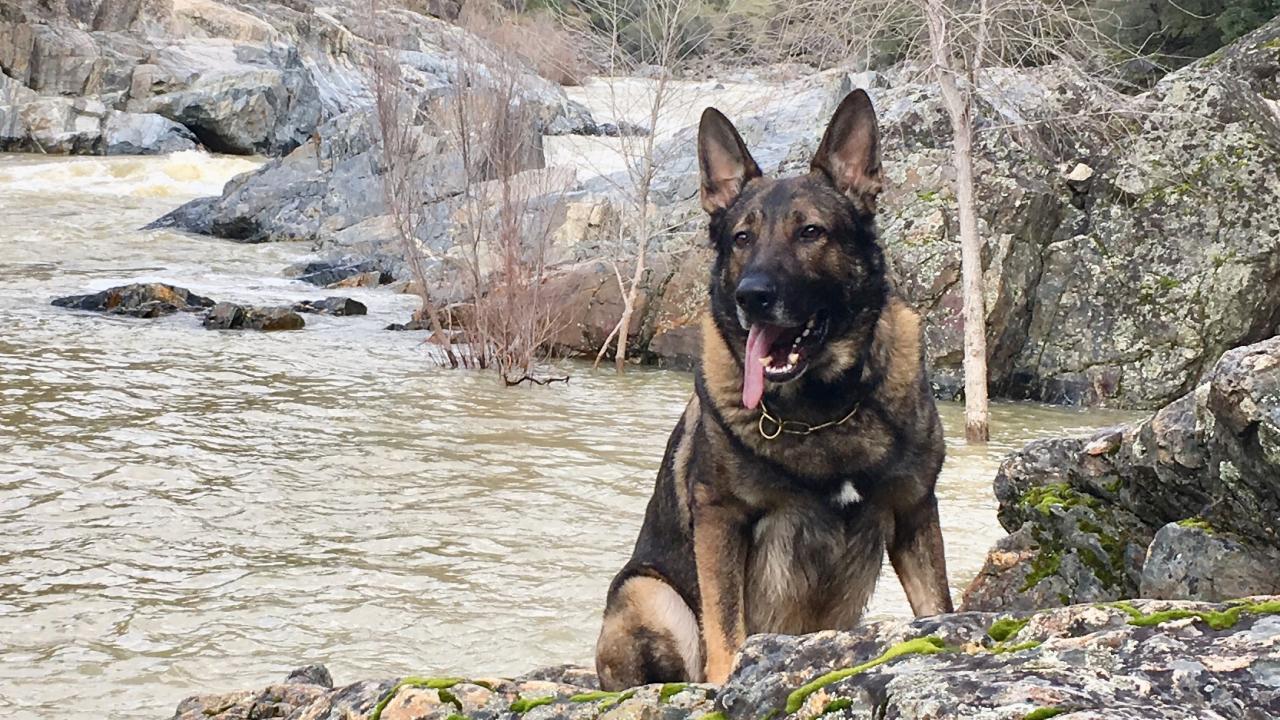
Novel Treatment Leads to Dog’s Recovery
“Case of the Month” – December 2020
Life for Miro, a 5-year-old German shepherd, has been what his owner describes as an “emotional roller coaster” over the past two years. Several peaks and valleys have dotted his metaphorical landscape as he has gone from premiere fitness to dealing with injuries and disease. But a clinical trial at the UC Davis veterinary hospital may have put him back on a positive track.

Working as a patrol dog with his handler/owner Martin Gilbertson, a ranger with California State Parks, Miro spent three years performing duties that required him to be at the top of his game. In early 2019, he was just that, having won the top dog award for his department.
By that summer, however, things started declining for Miro. He was diagnosed with lumbosacral intervertebral disc disease that caused spinal cord compression. UC Davis veterinary neurosurgeons performed a surgical decompression, and Miro eventually recovered after a lengthy recuperation period.
“Life was great,” said Gilbertson. “By early December 2019, Miro was cleared to return to work. I thought all the troubles were behind us.”
It only took a few weeks, though, until the roller coaster cleared a peak and started to descend.
In late December 2019, Miro collapsed for no apparent reason and started shaking in a way Gilbertson had never seen. So, the pair returned to UC Davis where Miro was diagnosed with myasthenia gravis, a disease in which there is a malfunction in the transmission of signals between the nerves and muscles. This causes muscle weakness, and an inability to walk or run properly, as well as potentially devastating neuromuscular disorders.
Gilbertson was devastated.
“To go from the pinnacle of our profession to potentially being a ‘couch potato’ at best for the rest of his life was a real gut check,” he said.
But hope appeared a few weeks later when Neurology/Neurosurgery Service faculty members Drs. Pete Dickinson and Bev Sturges informed Gilbertson of a myasthenia gravis clinical trial they were beginning with the help of the school’s Center for Companion Animal Health (CCAH) and the Veterinary Institute for Regenerative Cures.
“I thought, ‘What do we have to lose?’” stated Gilbertson. “Dr. Dickinson told me that Miro would be the first dog to ever receive this new treatment. We were excited and grateful to be able to participate.”

Over the next few months, Miro received three stem cell treatments, as well as traditional medications to treat myasthenia gravis. Additionally, part of Miro’s recovery involved examining his gait, which utilized a new piece of equipment aimed at better analyzing a dog’s stride pattern. Thanks to CCAH funding, the school recently acquired a Tekscan Strideway pressure walkway that allows clinicians and researchers to better gauge a patient’s step pattern and make decisions about their optimal care and recovery. To fully understand a patient’s gait abnormalities associated with injuries or neuromuscular diseases, veterinarians and researchers rely on objective, quantitative ways to assess locomotor function. The Strideway system complements the force plates in the school’s J.D. Wheat Veterinary Orthopedic Research Laboratory, which captures extensive information, but only for one gait step. The new pressure walkway expands the capabilities to quantify pressure, vertical force, and stride parameters (timing and spacing) on all limbs for several strides during walking, trotting or landing. Miro’s progress was able to be tracked with pinpoint accuracy throughout his recovery.
Before the trial, Miro could only walk about 10 steps before falling down. After the trial, he seemed fully recovered, and blood tests revealed no trace of antibodies to the disease. While the disease may not be completely gone from his system, the clinical trial seems to have repressed the disease to a point where it no longer inhibits Miro from his normal activities. Retired from his job, Miro now enjoys life as a family pet.
It is true that Miro is now in remission, but until more analysis of data is completed, it is still too early to determine if the stem cells were the driving force behind his recovery, since they were administered at the same time as standard-of-care medications. Miro’s results are being closely examined, along with the results of two other dogs that have completed the trial, to see if this stem cells treatment truly can be considered a cure for myasthenia gravis. Regardless of the final outcome of the study, Miro’s recovery, in one way or another, came from a novel combination of treatments pioneered at UC Davis.
# # #
